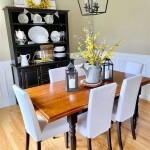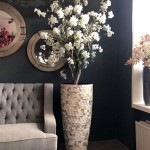What Colors Go With Farmhouse Decor?
Farmhouse decor evokes a sense of warmth, comfort, and timeless simplicity. Achieving the authentic farmhouse aesthetic requires careful consideration of color palettes. The right colors can enhance the rustic charm and create a welcoming atmosphere, while the wrong choices can detract from the intended style. This article explores the color spectrum that complements farmhouse decor, providing guidance for selecting hues that align with this enduring design trend.
Traditionally, farmhouse style draws inspiration from natural surroundings and the practicality of rural life. Therefore, color choices often reflect these origins, incorporating muted tones, natural materials, and a touch of vintage appeal. Understanding the core principles of farmhouse color palettes is essential for creating a cohesive and authentic look. Colors are frequently used to highlight architectural details, accentuate natural textures, and create a sense of spaciousness and light.
Neutral Foundations: The Cornerstone of Farmhouse Palettes
Neutral colors serve as the bedrock of farmhouse decor. They provide a versatile canvas upon which other colors and textures can be layered. These neutral shades offer a timeless appeal and contribute to the overall feeling of serenity and simplicity that is characteristic of the farmhouse style. Common neutral color choices include various shades of white, gray, beige, and greige (a blend of gray and beige).
White: White is arguably the most popular color choice for farmhouse interiors. It provides a clean and bright backdrop that allows other elements to stand out. Different shades of white, such as creamy white, antique white, and off-white, can add depth and dimension to a room. White walls are particularly effective in maximizing natural light and creating the illusion of more space. It pairs effectively with natural wood tones, metal accents, and pops of color through accessories.
Gray: Gray offers a cooler alternative to white, providing a sense of sophistication and tranquility. Light gray shades, such as dove gray and silver gray, are excellent choices for walls, while darker grays can be used for accent pieces or furniture. Gray complements a wide range of colors, including blues, greens, and yellows, making it a versatile option for farmhouse decor. It also pairs well with industrial-inspired elements like metal and concrete.
Beige: Beige provides a warmer and more inviting alternative to white. It offers a sense of comfort and familiarity, reminiscent of natural materials like linen and burlap. Beige shades, such as sand beige and oatmeal beige, are excellent choices for creating a cozy and relaxed atmosphere. They pair well with natural wood tones, woven textures, and earthy colors like brown and green.
Greige: Greige, a blend of gray and beige, combines the coolness of gray with the warmth of beige. This versatile color offers a balanced neutral that works well in a variety of settings. It provides a sophisticated yet approachable backdrop that complements both warm and cool colors. Greige is a popular choice for walls, furniture, and flooring, offering a neutral canvas that can be easily adapted to different styles and seasons.
Earthy Accents: Bringing Nature Indoors
Earthy tones are integral to farmhouse decor, reflecting the natural landscapes that inspire the style. These organic hues bring a sense of grounding and connection to the outdoors, creating a harmonious and inviting atmosphere. Common earthy accent colors include greens, browns, blues, and terra cottas, often in muted or weathered shades.
Greens: Green evokes a sense of nature, freshness, and tranquility. Muted greens, such as sage green, olive green, and moss green, are particularly well-suited to farmhouse decor. These shades can be used on walls, furniture, or accessories to bring a touch of the outdoors inside. Green pairs well with natural wood tones, white, and other earthy colors like brown and beige. Incorporating plants and greenery is another excellent way to introduce green into a farmhouse space.
Browns: Brown represents earth, stability, and warmth. Different shades of brown, such as chocolate brown, caramel brown, and tan, can add depth and richness to a farmhouse interior. Brown is often used for furniture, flooring, and accent pieces, creating a sense of grounding and comfort. Natural wood tones, such as oak, maple, and walnut, are also essential elements of farmhouse decor, bringing warmth and character to the space. Brown pairs well with white, beige, and other earthy colors.
Blues: Blue evokes a sense of calm, serenity, and spaciousness. Muted blues, such as powder blue, denim blue, and slate blue, are commonly used in farmhouse decor to create a relaxed and inviting atmosphere. These shades can be used on walls, furniture, or accessories to add a touch of color without overwhelming the space. Blue pairs well with white, gray, and other neutral colors. It also complements natural textures like linen and cotton.
Terra Cottas: Terracotta represents warmth, earthiness, and rustic charm. Terracotta shades, ranging from light peach to deep brick red, can add a touch of warmth and character to a farmhouse interior. Terracotta is often used for flooring, pottery, and other accent pieces, bringing a sense of history and authenticity to the space. Terracotta pairs well with white, beige, and other earthy colors like green and brown.
Vintage Pops: Adding Character and Personality
Vintage-inspired colors add character and personality to farmhouse decor, reflecting the style's emphasis on history and tradition. These colors are often muted, faded, or aged, creating a sense of nostalgia and authenticity. Common vintage accent colors include pastel shades, such as pale pink, baby blue, and mint green, as well as bolder colors like mustard yellow and rusty red.
Pastel Shades: Pastel shades evoke a sense of sweetness, femininity, and nostalgia. Pale pink, baby blue, and mint green can be used to add a touch of color without overwhelming the space. These shades are often used for accent pieces, such as throw pillows, blankets, and vintage furniture. Pastel shades pair well with white, gray, and other neutral colors, creating a soft and inviting atmosphere.
Mustard Yellow: Mustard yellow adds a touch of warmth, energy, and vintage charm. This bold color can be used to create a focal point in a room or to add a pop of color to an otherwise neutral palette. Mustard yellow is often used for accent pieces, such as lamps, chairs, and decorative objects. It pairs well with gray, brown, and other earthy colors, creating a warm and inviting atmosphere.
Rusty Red: Rusty red evokes a sense of warmth, history, and rustic charm. This earthy color can be used to add depth and character to a farmhouse interior. Rusty red is often used for accent pieces, such as rugs, curtains, and vintage furniture. It pairs well with white, beige, and other earthy colors like green and brown.
Employing these color principles allows for the creation of a farmhouse aesthetic that is both timeless and personalized. The key is to balance neutral foundations with carefully chosen accent colors that reflect the surrounding environment and individual preferences. The result is a space that radiates warmth, comfort, and enduring style.
Careful coordination of these colors and textures is essential in achieving the desired farmhouse aesthetic. It is advisable to sample paint colors in the intended space to observe how they interact with natural light and existing furnishings. The strategic use of color can transform a house into a home that reflects the enduring charm of the farmhouse tradition.

How To Add Color Your Farmhouse With Ease The Cottage Market

Mixing Color And Farmhouse Style Jordecor

Ways To Infuse Color In Your Space Courtney Warren Home

Top 15 Creative Tips To Modern Farmhouse Interior Hayooo Paint Colors

Our House Modern Farmhouse Paint Colors Christina Maria Blog

Farmhouse Style Paint Colors And Decor Decorating

How To Choose The Perfect Farmhouse Paint Colors

18 Farmhouse Decorating Ideas For Your Home Extra Space Storage

Best Types Of Paint Colors For Farmhouse Décor In 2025

Farmhouse Paint Colors By Benjamin Moore
Related Posts







